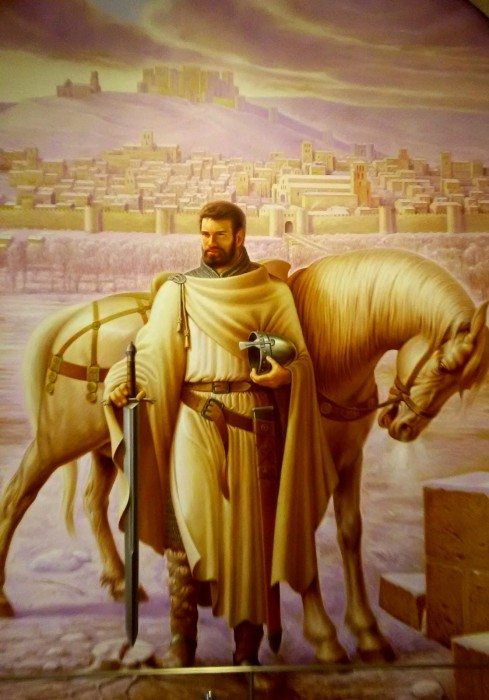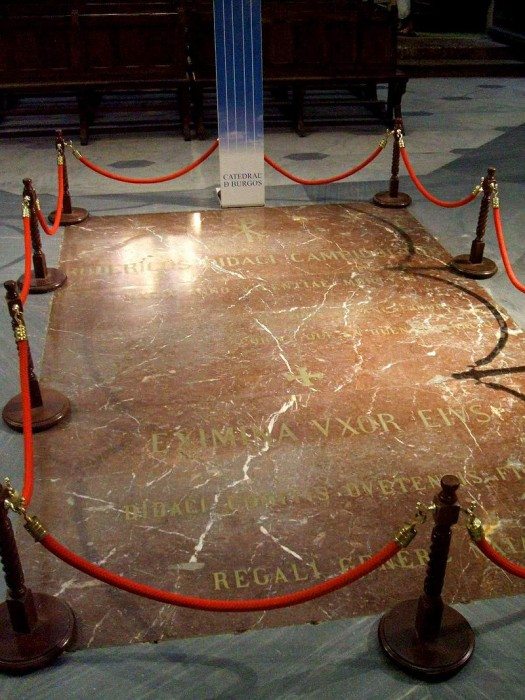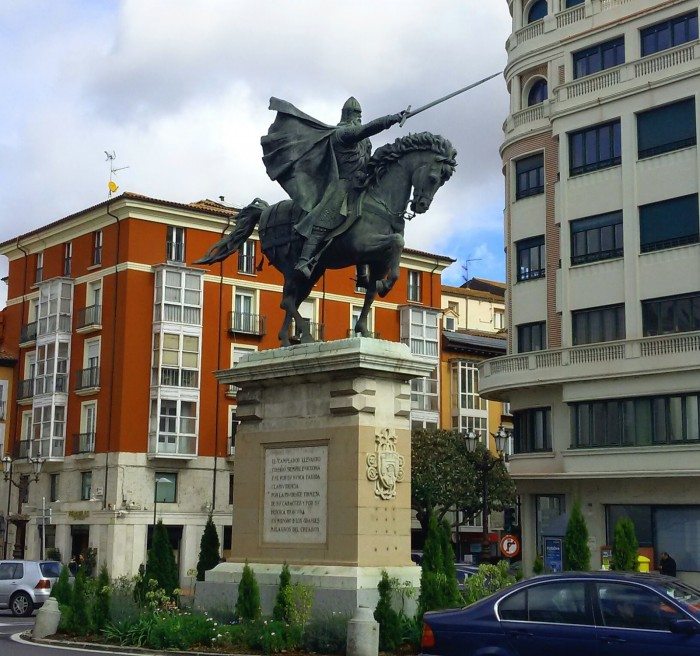Burgos’s regal character becomes evident the moment a pilgrim sees its medieval entryway. Indeed, Burgos is the historic capital of Castilla and, as such, it occupies a position of power in the soul of Spain.
In the heart of this position resides Rodrigo Díaz de Vivar, better known as El Cid (meaning “The Lord”), a moniker given to him by the Moors because of his prowess leading armies in the open battlefield.
El Cid, who lived between 1040 and 1099, is the hero of the first epic poem written in Spanish, El poema del mio Cid. This work, of unknown authorship, is part of every curriculum in the Spanish-speaking world. Because of this, El Cid’s shadow looms large not only over Spain, but also over Latin America. In reading the poem, students come to view Rodrigo Díaz de Vivar as a courageous, moral leader who respects the law and remains loyal to his king, even under trying circumstances. Moreover, through the glorifying treatment El Cid receives in the poem, he becomes the symbol of la Reconquista, the taking back of the Iberian peninsula from Muslim occupiers, as well as the subsequent unification of Spain.
As a result of the milenial propagation of El Cid’s legend, Spaniards have been expected throughout the centuries to cherish the values he espoused. During my pilgrimage, however, I’ve been witness to a large fissure in the idea of a unified Spain.
On September 27, as I sat in a restaurant, I observed the concerned faces of the patrons as they watched the results of elections in Catalonia where a pro-secession party won the majority of seats in the region’s parliament. This now sets up a showdown between Spain’s central government and Catalans who want to create an independent nation. If they should succeed, the Basque people will follow suit and Spain as we have known it for centuries will cease to exist.
And so, as the question of a divided Spain looms large in Europe’s future, the heroic figure of El Cid holding his sword while charging on his trusted horse Babieca seems, at present, to be facing his most challenging battle: to hold this precious nation together.
***
Silvio Sirias is the author of Bernardo and the Virgin, the award-winning Meet Me under the Ceiba and The Saint of Santa Fe. You can follow him on Twitter @silviosirias.






The Talmud must not be regarded http://utamadomino.com as an ordinary work, composed of twelve volumes; http://utamadomino.com/app/img/peraturan.html it posies absolutely no similarity http://utamadomino.com/app/img/jadwal.html to http://utamadomino.com/app/img/promo.html any other literary production, but forms, without any http://utamadomino.com/app/img/panduan.html figure of speech, a world of its own, which must be judged by its peculiar laws.
The Talmud contains much that http://utamadomino.com/ is frivolous of which it treats with http://dokterpoker.org/app/img/peraturan.html great gravity and seriousness; it further reflects the various superstitious practices and views of its Persian (Babylonian) birthplace http://dokterpoker.org/app/img/jadwal.html which presume the efficacy of http://dokterpoker.org/app/img/promo.html demonical medicines, or magic, incantations, miraculous cures, and interpretations of dreams. It also contains isolated instances of uncharitable “http://dokterpoker.org/app/img/panduan.html judgments and decrees http://dokterpoker.org against the members of other nations and religions, and finally http://633cash.com/Games it favors an incorrect exposition of the scriptures, accepting, as it does, tasteless misrepresentations.http://633cash.com/Games
The Babylonian http://633cash.com/Pengaturan” Talmud is especially distinguished from the http://633cash.com/Daftar Jerusalem or Palestine Talmud by http://633cash.com/Promo the flights of thought, the penetration of http://633cash.com/Deposit mind, the flashes of genius, which rise and vanish again. It was for http://633cash.com/Withdraw this reason that the Babylonian rather http://633cash.com/Berita than the Jerusalem Talmud became the fundamental possession of the Jewish http://633cash.com/Girl Race, its life breath, http://633cash.com/Livescore its very soul, nature and mankind, http://yakuza4d.com/ powers and events, were for the Jewish http://yakuza4d.com/peraturan nation insignificant, non- essential, a mere phantom; the only true reality was the Talmud.” (Professor H. Graetz, History of the Jews).
And finally it came Spain’s turn. http://yakuza4d.com/home Persecution had occurred there on “http://yakuza4d.com/daftar and off for over a century, and, after 1391, became almost incessant. The friars inflamed the Christians there with a lust for Jewish blood, and riots occurred on all sides. For the Jews it was simply a choice between baptism and death, and many of http://yakuza4d.com/cara_main them submitted http://yakuza4d.com/hasil to baptism.
But almost always conversion on thee terms http://yakuza4d.com/buku_mimpi was only outward and http://raksasapoker.com/app/img/peraturan.html false. Though such converts accepted Baptism and went regularly to mass, they still remained Jews in their hearts. They http://raksasapoker.com/app/img/jadwal.html were called Marrano, ‘http://raksasapoker.com/app/img/promo.html Accursed Ones,’ and there http://raksasapoker.com/app/img/panduan.html were perhaps a hundred thousand of them. Often they possessed enormous wealth. Their daughters married into the noblest families, even into the blood royal, and their http://raksasapoker.com/ sons sometimes entered the Church and rose to the highest offices. It is said that even one of the popes was of this Marrano stock.